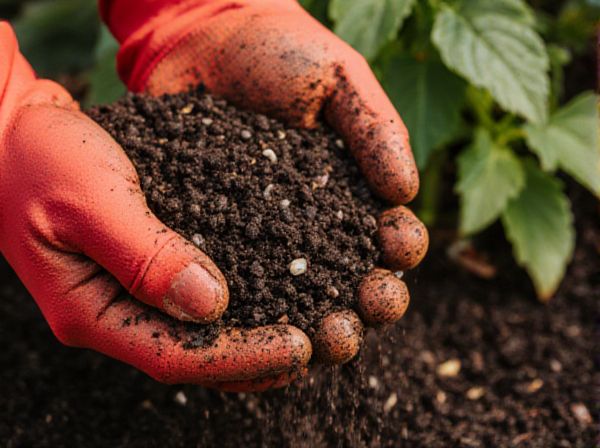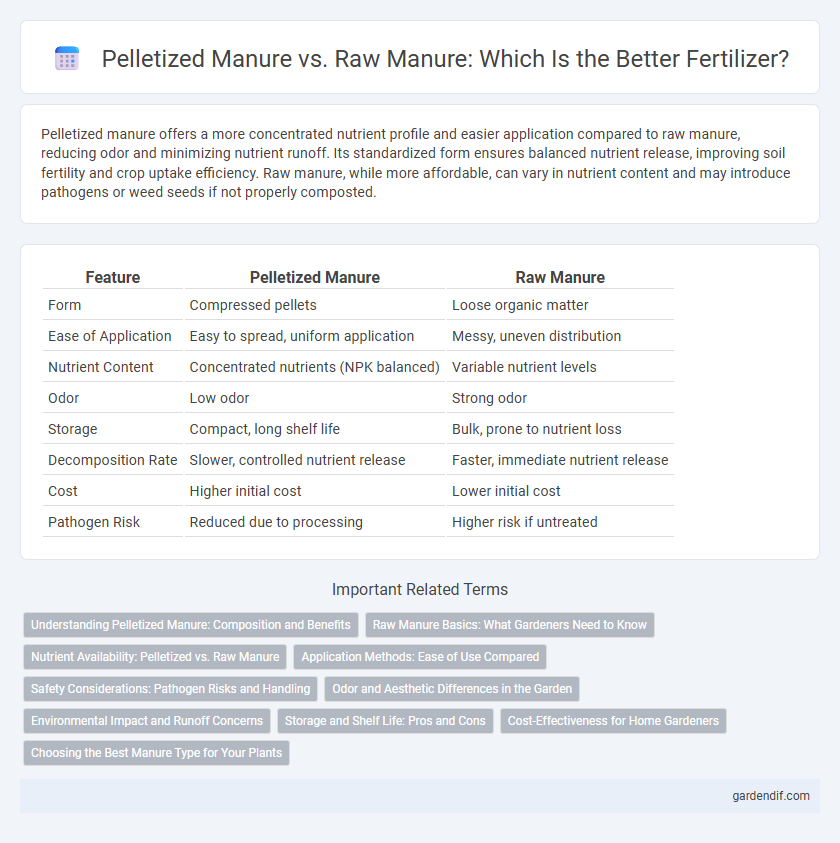
Pelletized manure vs raw manure Illustration
Pelletized manure offers a more concentrated nutrient profile and easier application compared to raw manure, reducing odor and minimizing nutrient runoff. Its standardized form ensures balanced nutrient release, improving soil fertility and crop uptake efficiency. Raw manure, while more affordable, can vary in nutrient content and may introduce pathogens or weed seeds if not properly composted.
Table of Comparison
| Feature | Pelletized Manure | Raw Manure |
|---|---|---|
| Form | Compressed pellets | Loose organic matter |
| Ease of Application | Easy to spread, uniform application | Messy, uneven distribution |
| Nutrient Content | Concentrated nutrients (NPK balanced) | Variable nutrient levels |
| Odor | Low odor | Strong odor |
| Storage | Compact, long shelf life | Bulk, prone to nutrient loss |
| Decomposition Rate | Slower, controlled nutrient release | Faster, immediate nutrient release |
| Cost | Higher initial cost | Lower initial cost |
| Pathogen Risk | Reduced due to processing | Higher risk if untreated |
Understanding Pelletized Manure: Composition and Benefits
Pelletized manure is composed of finely ground organic waste that is processed into uniform pellets, offering concentrated nutrients such as nitrogen, phosphorus, and potassium. This form improves nutrient retention and reduces odor compared to raw manure, enhancing soil fertility effectively. The controlled release of nutrients from pelletized manure supports sustained plant growth and minimizes environmental runoff.
Raw Manure Basics: What Gardeners Need to Know
Raw manure contains essential nutrients like nitrogen, phosphorus, and potassium crucial for plant growth but requires proper composting to prevent harmful pathogens and weed seeds from affecting garden health. Its higher moisture content and bulkiness can make application more labor-intensive compared to pelletized manure, which is drier and more concentrated. Gardeners must consider the risk of nutrient imbalances and soil contamination when using raw manure and ensure adequate aging or composting time to optimize soil fertility safely.
Nutrient Availability: Pelletized vs. Raw Manure
Pelletized manure offers enhanced nutrient availability compared to raw manure due to its concentrated form and slower nutrient release, providing a more controlled supply of nitrogen, phosphorus, and potassium to plants. Raw manure contains higher moisture and variable nutrient content, which can lead to nutrient runoff and inconsistent soil enrichment. The pelletization process reduces nutrient loss, improves storage and handling, and increases fertilizer efficiency by enabling more precise application rates.
Application Methods: Ease of Use Compared
Pelletized manure offers greater ease of use in application compared to raw manure due to its uniform size and dry consistency, allowing for simple spreading with standard fertilizer spreaders. Raw manure often requires additional preparation and can be cumbersome to handle because of its high moisture content and irregular texture. The pelletized form also reduces odor and minimizes nutrient runoff, enhancing precision and efficiency in fertilization practices.
Safety Considerations: Pathogen Risks and Handling
Pelletized manure undergoes a drying and heating process that significantly reduces pathogen risks compared to raw manure, making it safer for handling and application. Raw manure often contains harmful bacteria such as E. coli and Salmonella, posing higher health risks to farm workers and the environment if not properly managed. Proper storage, handling, and application techniques are essential for both but pelletized manure generally offers a safer alternative due to its enhanced pathogen reduction.
Odor and Aesthetic Differences in the Garden
Pelletized manure significantly reduces odor compared to raw manure due to its dried and compacted form, minimizing ammonia emissions and unpleasant smells in the garden. Its uniform pellet structure also enhances aesthetic appeal, preventing the messy, uneven appearance of raw manure spreading across soil surfaces. This makes pelletized manure a preferable choice for gardeners seeking effective fertilization without compromising garden cleanliness and comfort.
Environmental Impact and Runoff Concerns
Pelletized manure reduces nutrient runoff by providing a slow-release nutrient source, minimizing leaching and groundwater contamination compared to raw manure. Its concentrated form lowers the volume needed for application, decreasing soil erosion and surface runoff risks. Raw manure, with higher moisture content, poses greater environmental threats due to potential nutrient leaching and odor emissions, which can impair nearby water bodies and ecosystems.
Storage and Shelf Life: Pros and Cons
Pelletized manure offers improved storage stability and extended shelf life due to its low moisture content, reducing odor and minimizing nutrient loss over time. Raw manure requires immediate use or proper composting to prevent nutrient degradation and odor problems, leading to shorter storage duration. While pelletized manure facilitates easier handling and prolonged usability, raw manure's higher moisture content can cause faster spoilage and increased storage challenges.
Cost-Effectiveness for Home Gardeners
Pelletized manure offers superior cost-effectiveness for home gardeners by providing concentrated nutrients that reduce application frequency and minimize waste compared to raw manure. The dry, compact form of pelletized manure allows for easier storage and precise measurement, preventing overuse and nutrient runoff often associated with raw manure. Although pelletized manure may have a higher upfront cost, the long-term savings from enhanced nutrient efficiency and reduced labor make it a more economical choice for backyard gardening.
Choosing the Best Manure Type for Your Plants
Pelletized manure offers concentrated nutrients and is easier to handle, making it ideal for targeted feeding and slow nutrient release. Raw manure provides a more natural, organic amendment that improves soil texture and microbial activity but may require composting to reduce pathogens and odors. Selecting the best manure depends on plant type, soil condition, and nutrient needs, with pelletized manure suited for balanced nutrient delivery and raw manure enhancing long-term soil health.
Pelletized manure vs raw manure Infographic

 gardendif.com
gardendif.com